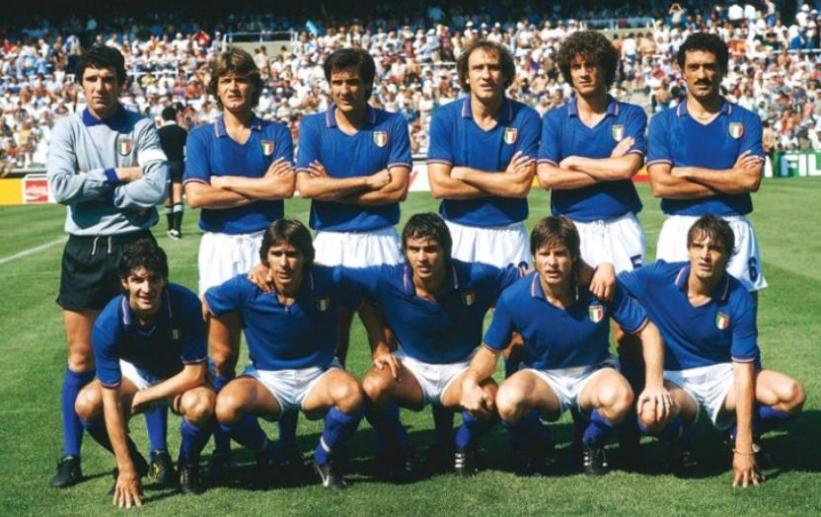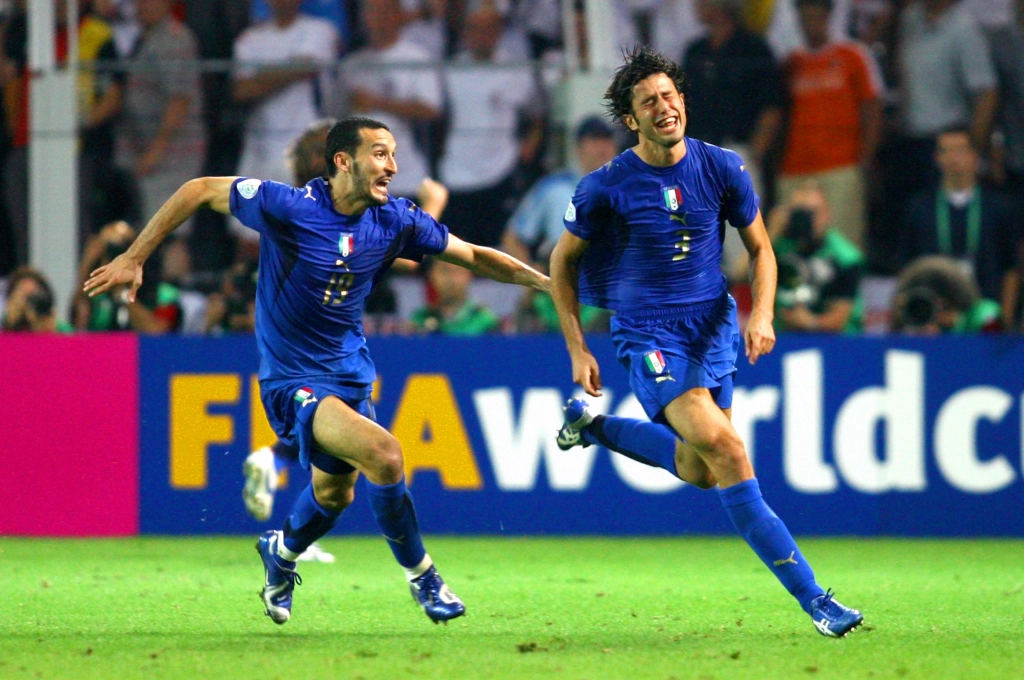For generations of football fans, Italy are the quintessential World Cup team. Skilful, stylish and exciting, Gli Azzurri have been involved in some iconic World Cup moments. While many reminisce about the 1982 final victory over West Germany, or the magic of Roberto Baggio in the nineties, a special mention must be given to Italy’s 2006 triumph in Germany. But while the defeat of France in the final hogged the headlines, the semi-final victory against perennial foes Germany was undoubtedly one of Italy’s most important and dramatic World Cup wins. The narrative and context of the occasion, the A-list cast, the big saves, the last minute goals – this game had the lot. Due to the circumstances of the time, the victory had a greater significance than simply reaching the World Cup Final.
After losing to France in the Final of Euro 2000, Italy’s performances at major tournaments slumped. Following defeat in the Round of 16 (to South Korea) at the 2002 World Cup, and Group Stage elimination at Euro 2004, the Azzurri needed a drastic upturn in fortune to avoid becoming a laughing stock on the world stage. So when the Calciopoli scandal erupted in May 2006, it’s safe to say that expectations for Italy’s World Cup campaign were not high.
Crucial World Cup preparations were underway when the news broke that five Italian teams (Juventus, AC Milan, Lazio, Fiorentina and Reggina) were involved in the manipulation of refereeing appointments, a form of match fixing. The Sports Prosecutor came down hard on the offending clubs, demoting Juventus to Serie B and deducting points from the others. Italian football was in disgrace and the pride of a nation, intrinsically linked to football, had been dented. The national team could not escape it; at the time over half of the Italian squad played for Calciopoli sides, so naturally the situation was very unsettling.
But despite the controversy and shame that Calciopoli brought, the scandal turned out to be a blessing in disguise. The fiasco galvanised the squad. United by a collective desire for redemption in a time of desperation, the Azzurri were the nation’s only hope of restoring national pride. While the winds of controversy swirled around the world of calcio, Italy did their talking on the pitch.
Italy went into the semi-final in imperious form. After topping Group E thanks to 2-0 victories against Ghana and the Czech Republic and a 1-1 draw with the USA, Lippi’s side squeezed past Australia in the round of sixteen before mauling Ukraine in the last eight. The talismanic Fabio Cannavaro captained the side, leading a stout defence that kept four clean sheets in their opening five games. But they were far from a defensive team. Italy could create overloads on the flanks with attacking full backs Gianluca Zambrotta and Fabio Grosso combining with the tenacity of wingers like Simone Perotta and Mauro Camoranesi. The centre of the park was commanded by midfield General Gennaro Gattuso, whose forceful style was complemented perfectly by the vision and finesse of Andrea Pirlo. Up front, the options were abundant. Lippi had four world class strikers at his disposal; Luca Toni, Francesco Totti, Alberto Gilardino and Alessandro Del Piero. Italy had a multi-faceted attack that could cause problems in a multitude of ways.
July 4th brought the meeting of the two European giants and the anticipation was palpable. The pair had history with each other, Italy enjoying more success thanks to victories at the 1970 World Cup and the 1982 World Cup Final. But it was Germany that entered this contest as favourites.
With Die Mannschaft legend Jurgen Klinsmen at the helm, a new generation of younger, more skillful players were ushered in to play a more attractive style, replacing the brute strength and rigid organisation of past German sides. With the will of the German people behind them, coupled with Germany’s undefeated record at the Westfalenstadion, the odds seemed firmly stacked against Marcello Lippi’s Italy.
With the ever vociferous Südtribüne packed with 25,000 bouncing German fans, the match began. After starting well and missing a few chances, Italy allowed Germany’s presence in the game to grow. The hosts wasted the game’s first clear-cut chance, as Schneider blazed over after finding himself in acres of space. Germany continued to find gaps in Italy’s defensive wall, calling Buffon into action to block from Miroslav Klose and parry Podolski’s stinging effort. Italy had marginally been the better side, but they were in danger of letting Germany snatch the win. The opening ninety minutes, although very entertaining as nil-nils go, was just the warm up for the main event.

Azzurri: The story behind Italy’s nickname and colours
Extra time had a frantic feel to it as both sides raised the tempo and committed men forward, ensuring an end to end 30 minutes. The first two blows were dealt by Italy, but Germany didn’t go down. From a throw-in 30 yards out, Alberto Gilardino escaped from Metzelder’s tame defensive effort and burst into the box. As he reached the by-line, Gilardino cut inside onto his left, side stepped a bamboozled Michael Ballack and poked and effort with his left. Wrong-footed, Lehmann in the German goal was beaten, but the post wasn’t. Moments later the woodwork again thwarted Italy. Lurking at the edge of the box, Zambrotta collected a headed clearance from Pirlo’s corner and unleashed a rocket. With Lehmann a spectator like the 25,000 stood behind him, the shot zipped through the air and cannoned off the top of the bar. The narrowest of margins had twice denied the Azzurri, and it looked like it wouldn’t be their day.
Germany responded, but Lukas Podolski twice couldn’t take advantage. After getting his angles wrong and heading wide, he forced Buffon into a wonderful save. Sebastien Kehl sprayed the ball wide to the left hand side of the box, where the Polish-born striker unleashed a pile driver destined for the top corner. With cat like reactions, Italy’s number one leapt into the air, thrusting up a big right palm to divert the ball over the crossbar. It was the kind of save that wins games, and it turned out to be a vital one.
Playing at his first major tournament, Italian full back Fabio Grosso was not particularly well known on the world stage. Before that summer, he had enjoyed a modest but successful career in Italy, turning out for Renato Curi, Chieti, Perugia and Palermo. Strong and quick with good crossing and set piece ability, Grosso was a modern fullback who offered an alternative to the defensiveness of former internationals Maldini and Panucci. Grosso was not, however, renowned for his goal scoring ability.
“GROSSO! GROSSO! GOOOOOLL! GOL DI GROSSO! GOL DI GROSSO!”. The explosion of passion from Sky Italia’s commentator, Fabio Caressa, was representative of every Azzurri fan, quite possibly every Italian. But it wasn’t just the sudden release of tension and emotion that has made this goal iconic. The simplicity yet effectiveness of the move, and its seismic significance, make it special.
Unusually, given his role as set-piece specialist, it was not Andrea Pirlo who took the corner, but Alessandro Del Piero. Subsequently, when a headed clearance fell at the edge of the area, Italy’s premier playmaker was lying in wait. Dribbling to his right, with a wall of four German players approaching, it looked like Pirlo had held onto the ball for too long. Then at the last possible second, l’architetto threaded an audacious no-look pass. As the ball rolled between the advancing Metzelder and Schweinsteiger, Fabio Grosso stood totally unmarked.
Time stood still as the defender prepared himself. With the instinct of a striker and the technique of a midfield maestro, Grosso connected perfectly with the Pirlo’s through ball, sending a curling first time strike into the far corner of the goal. Lehmann was beaten and Germany’s dream of World Cup glory on home soil looked over. Grosso wheeled away in celebration, screaming, “Non ci credo!” (“I don’t believe it!”). The unlikeliest of heroes had put Italy in the unlikeliest of situations. But the drama was not over yet.
With barely seconds left on the clock and Germany pushing hard for an equalizer, Cannavaro stole possession deep in his half and surged forward. Totti took over and played in Gilardino, who suddenly found himself one on one with a backtracking Metzelder. As Gilardino cut inside at the edge of the area, Del Piero surged forward on the left hand-side, creating a two-on-one overlap situation. Everyone in the stadium could see what was going to happen, but Germany were powerless to prevent it. Gilardino duly found him with a well-timed reverse pass and Del Piero did what he does best. Running onto Gilardino’s pass, he coolly sent a trademark lobbed finish into the far top corner, over the head of the advancing Lehmann. It was a walk-off winner with no time for the restart. Pandemonium ensued on the bench and in the stands as the Azzurri basked in the glory of a famous victory.
Of course, we know the rest of the story. Italy would go on to lift the World Cup trophy after a penalty shootout victory against France, the first ever in a World Cup Final, but the occasion is largely remembered for the infamous Zidane head-butt. The man of the moment, Fabio Grosso, would again be the hero, scoring the winning spot-kick.
But for me, that’s not what I remember when I think of Germany 2006. I remember the 119th minute in Dortmund, when engulfed in sheer ecstasy and pride, Italy became united amidst its division. Only football could achieve this.
Words by Alex Brotherton: @alex_brotherton

